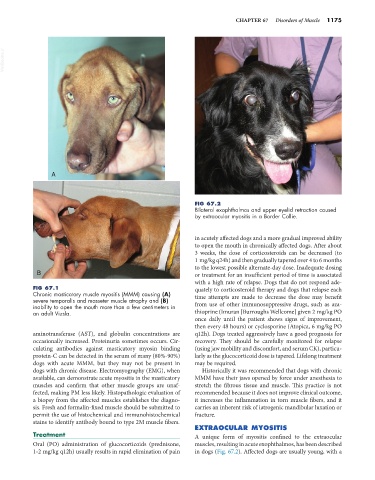Page 1203 - Small Animal Internal Medicine, 6th Edition
P. 1203
CHAPTER 67 Disorders of Muscle 1175
VetBooks.ir
A
FIG 67.2
Bilateral exophthalmos and upper eyelid retraction caused
by extraocular myositis in a Border Collie.
in acutely affected dogs and a more gradual improved ability
to open the mouth in chronically affected dogs. After about
3 weeks, the dose of corticosteroids can be decreased (to
1 mg/kg q24h) and then gradually tapered over 4 to 6 months
to the lowest possible alternate-day dose. Inadequate dosing
B or treatment for an insufficient period of time is associated
with a high rate of relapse. Dogs that do not respond ade-
FIG 67.1 quately to corticosteroid therapy and dogs that relapse each
Chronic masticatory muscle myositis (MMM) causing (A) time attempts are made to decrease the dose may benefit
severe temporalis and masseter muscle atrophy and (B)
inability to open the mouth more than a few centimeters in from use of other immunosuppressive drugs, such as aza-
an adult Vizsla. thioprine (Imuran [Burroughs Wellcome] given 2 mg/kg PO
once daily until the patient shows signs of improvement,
then every 48 hours) or cyclosporine (Atopica, 6 mg/kg PO
aminotransferase (AST), and globulin concentrations are q12h). Dogs treated aggressively have a good prognosis for
occasionally increased. Proteinuria sometimes occurs. Cir- recovery. They should be carefully monitored for relapse
culating antibodies against masticatory myosin binding (using jaw mobility and discomfort, and serum CK), particu-
protein-C can be detected in the serum of many (80%-90%) larly as the glucocorticoid dose is tapered. Lifelong treatment
dogs with acute MMM, but they may not be present in may be required.
dogs with chronic disease. Electromyography (EMG), when Historically it was recommended that dogs with chronic
available, can demonstrate acute myositis in the masticatory MMM have their jaws opened by force under anesthesia to
muscles and confirm that other muscle groups are unaf- stretch the fibrous tissue and muscle. This practice is not
fected, making PM less likely. Histopathologic evaluation of recommended because it does not improve clinical outcome,
a biopsy from the affected muscles establishes the diagno- it increases the inflammation in torn muscle fibers, and it
sis. Fresh and formalin-fixed muscle should be submitted to carries an inherent risk of iatrogenic mandibular luxation or
permit the use of histochemical and immunohistochemical fracture.
stains to identify antibody bound to type 2M muscle fibers.
EXTRAOCULAR MYOSITIS
Treatment A unique form of myositis confined to the extraocular
Oral (PO) administration of glucocorticoids (prednisone, muscles, resulting in acute exophthalmos, has been described
1-2 mg/kg q12h) usually results in rapid elimination of pain in dogs (Fig. 67.2). Affected dogs are usually young, with a

